Estimating Hydrogen Price Based on Combined Machine Learning Models by 2060: Especially Comparing Regional Variations in China
Abstract
1. Introduction
2. Costs of Technologies
2.1. Steam Methane Reforming (SMR)
2.2. Coal
2.3. Water Electrolysis
3. Methods and Data
3.1. Methods
3.1.1. PSO-BP
- Define the fitness function: the prediction accuracy is selected as the fitness function.
- Define parameter space: The BP neural network hyperparameters and ranges are determined. Usually, BP neural network hyperparameters include weights and biases.
- Initialize the particle swarm: a group of particles is created, each particle represents a hyperparameter combination of a BP neural network, and the particle position (hyperparameter value) and speed are initialized.
- Iterative optimization: The number of iterations is set. In each iteration, the position and velocity of the particle are updated and the fitness value is calculated.
- Set stopping criteria: the stopping criteria are set, such as a maximum number of iterations.
- Select the particle: after the optimization is completed, the particle with the best fitness is selected from the swarm, and its position is the desired BP neural network parameter.
3.1.2. BO-LSSVM
- Define the objective function: The prediction accuracy is selected as the objective function. The objective function takes the hyperparameters of the LSSVM as input and returns the corresponding performance metric.
- Select the hyperparameters: the regularization parameter and RBF kernel function parameter are selected as the hyperparameters to optimize in this article.
- Initialize the Bayesian optimization process: The GPs are chosen for the objective function and a small number of random samples of hyperparameters are initialized to evaluate the objective function. The samples are served as the starting point for the optimization.
- Evaluate the initial samples: the LSSVM model is trained using the selected hyperparameters from the initial samples, and the performance of LSSVM is evaluated on the validation set.
- Update the Gaussian process model: the GPs model is updated by applying the observed hyperparameters.
- Optimize the acquisition function: the acquisition function is defined and optimized to find the next set of hyperparameters.
- Evaluate the new hyperparameters: the LSSVM model is trained using the new hyperparameters and evaluated on the test set.
- Iterate: the number of iterations is set as the stopping criterion, and steps 5 to 7 are repeated until the stopping criterion is met.
- Select the optimal hyperparameters: the optimal hyperparameters are selected after the optimization process is complete.
- Train the model and evaluate the performance: the LSSVM model is trained with the optimal hyperparameters and the performance of LSSVM is evaluated on the test set.
3.1.3. Model Evaluation
3.2. Data
3.3. Training
4. Results and Discussion
4.1. Estimation of National Average Hydrogen Prices
4.2. Estimation of Hydrogen Prices Comparing Regional Variations
5. Conclusions
Author Contributions
Funding
Institutional Review Board Statement
Informed Consent Statement
Data Availability Statement
Conflicts of Interest
Appendix A
| Year | FCV Ownership | Synthetic Ammonia Production/104t | Methanol Production/104t | Gasoline Production/104t | Diesel Production/104t |
|---|---|---|---|---|---|
| 2012 | 0 | 5528 | 3129 | 9000 | 17,063 |
| 2013 | 0 | 5385 | 2812 | 9800 | 17,275 |
| 2014 | 0 | 5700 | 3630 | 11,000 | 17,635 |
| 2015 | 10 | 5791 | 3886 | 12,100 | 18,008 |
| 2016 | 639 | 5708 | 4193 | 12,900 | 17,917 |
| 2017 | 1914 | 4946 | 4448 | 13,300 | 18,318 |
| 2018 | 3441 | 4587 | 5522 | 14,000 | 17,376 |
| 2019 | 6178 | 4755 | 6216 | 14,100 | 16,638 |
| 2020 | 7355 | 5117 | 6357 | 13,200 | 15,904 |
| 2021 | 8941 | 5189 | 7765 | 15,500 | 16,337 |
| 2022 | 12,730 | 5321 | 8100 | 14,600 | 19,125 |
| 2023 | 18,530 | 5489 | 8317 | 16,100 | 21,729 |
| Year | Natural Gas Price/(Yuan/t) | Coal Price/(Yuan/t) |
|---|---|---|
| 2012 | 5476 | 580 |
| 2013 | 6187 | 430 |
| 2014 | 5043 | 408 |
| 2015 | 4225 | 500 |
| 2016 | 4611 | 310 |
| 2017 | 3396 | 490.7 |
| 2018 | 3661 | 470 |
| 2019 | 4415 | 462 |
| 2020 | 3232 | 416.7 |
| 2021 | 3320 | 681.7 |
| 2022 | 8103 | 916 |
| 2023 | 5832 | 771.7 |
References
- Jung, J.; Lee, D.-J.; Yoshida, K. Comparison between Korean and Japanese consumers’ preferences for fuel cell electric vehicles. Transp. Res. Part. D Transp. Environ. 2022, 113, 103511. [Google Scholar] [CrossRef]
- Wang, Y.; Guo, C.; Chen, X.; Jia, L.; Guo, X.; Chen, R.; Zhang, M.; Chen, Z.; Wang, H. Carbon peak and carbon neutrality in China: Goals, implementation path and prospects. China Geol. 2021, 4, 720–746. [Google Scholar] [CrossRef]
- Yang, P.; Peng, S.; Benani, N.; Dong, L.; Li, X.; Liu, R.; Mao, G. An integrated evaluation on China’s provincial carbon peak and carbon neutrality. J. Clean. Prod. 2022, 377, 134497. [Google Scholar] [CrossRef]
- Dieterich, V.; Buttler, A.; Hanel, A.; Spliethoff, H.; Fendt, S. Power-to-liquid via synthesis of methanol, DME or Fischer-Tropsch-fuels: A review. Energy Environ. Sci. 2020, 13, 3207–3252. [Google Scholar] [CrossRef]
- Van Hoecke, L.; Laffineur, L.; Campe, R.; Perreault, P.; Verbruggen, S.W.; Lenaerts, S. Challenges in the use of hydrogen for maritime applications. Energy Environ. Sci. 2021, 14, 815–843. [Google Scholar] [CrossRef]
- Brändle, G.; Schönfisch, M.; Schulte, S. Estimating long-term global supply costs for low-carbon hydrogen. Appl. Energy 2021, 302, 117481. [Google Scholar] [CrossRef]
- Utomo, O.; Abeysekera, M.; Ugalde-Loo, C.E. Optimal operation of a hydrogen storage and fuel cell coupled integrated energy system. Sustainability 2021, 13, 3525. [Google Scholar] [CrossRef]
- Rasul, M.; Hazrat, M.; Sattar, M.; Jahirul, M.; Shearer, M. The future of hydrogen: Challenges on production, storage and applications. Energy Convers. Manag. 2022, 272, 116326. [Google Scholar] [CrossRef]
- Ajanovic, A.; Haas, R. Economic prospects and policy framework for hydrogen as fuel in the transport sector. Energy Policy 2018, 123, 280–288. [Google Scholar] [CrossRef]
- Le Duigou, A.; Quéméré, M.-M.; Marion, P.; Menanteau, P.; Decarre, S.; Sinegre, L.; Nadau, L.; Rastetter, A.; Cuni, A.; Mulard, P. Hydrogen pathways in France: Results of the HyFrance3 project. Energy Policy 2013, 62, 1562–1569. [Google Scholar] [CrossRef]
- Tang, O.; Rehme, J.; Cerin, P.; Huisingh, D. Hydrogen production in the Swedish power sector: Considering operational volatilities and long-term uncertainties. Energy Policy 2021, 148, 111990. [Google Scholar] [CrossRef]
- Zhigang, S.; Baolian, Y. Developing trend and present status of hydrogen energy and fuel cell development. Bull. Chin. Acad. Sci. 2019, 34, 469–477. [Google Scholar]
- Li, Y.; Kimura, S. Economic competitiveness and environmental implications of hydrogen energy and fuel cell electric vehicles in ASEAN countries: The current and future scenarios. Energy Policy 2021, 148, 111980. [Google Scholar] [CrossRef]
- Hu, D.; Zhang, J.; Huang, J.; Li, J.; Yang, Q.; Wang, J. Speed fluctuation suppression control of super-high-speed electric air compressors considering high-frequency electromagnetic excitation. IEEE Trans. Power Electron. 2024, 39, 9650–9660. [Google Scholar] [CrossRef]
- George, J.F.; Müller, V.P.; Winkler, J.; Ragwitz, M. Is blue hydrogen a bridging technology?-The limits of a CO2 price and the role of state-induced price components for green hydrogen production in Germany. Energy Policy 2022, 167, 113072. [Google Scholar] [CrossRef]
- Maggio, G.; Nicita, A.; Squadrito, G. How the hydrogen production from RES could change energy and fuel markets: A review of recent literature. Int. J. Hydrog. Energy 2019, 44, 11371–11384. [Google Scholar] [CrossRef]
- Ueckerdt, F.; Bauer, C.; Dirnaichner, A.; Everall, J.; Sacchi, R.; Luderer, G. Potential and risks of hydrogen-based e-fuels in climate change mitigation. Nat. Clim. Change 2021, 11, 384–393. [Google Scholar] [CrossRef]
- Glenk, G.; Reichelstein, S. Economics of converting renewable power to hydrogen. Nat. Energy 2019, 4, 216–222. [Google Scholar] [CrossRef]
- Dumančić, A.; Vlahinić Lenz, N.; Wagmann, L. Profitability Model of Green Hydrogen Production on an Existing Wind Power Plant Location. Sustainability 2024, 16, 1424. [Google Scholar] [CrossRef]
- González-Delgado, Á.D.; Vargas-Mira, A.; Zuluaga-García, C. Economic Evaluation and Technoeconomic Resilience Analysis of Two Routes for Hydrogen Production via Indirect Gasification in North Colombia. Sustainability 2023, 15, 16371. [Google Scholar] [CrossRef]
- Nicita, A.; Maggio, G.; Andaloro, A.; Squadrito, G. Green hydrogen as feedstock: Financial analysis of a photovoltaic-powered electrolysis plant. Int. J. Hydrog. Energy 2020, 45, 11395–11408. [Google Scholar] [CrossRef]
- Madeira, J.G.F.; Oliveira, E.M.; Springer, M.V.; Cabral, H.L.; do Carmo Barbeito, D.F.; Souza, A.P.G.; da Silva Moura, D.A.; Delgado, A.R.S. Hydrogen production from swine manure biogas via steam reforming of methane (SRM) and water gas shift (WGS): A ecological, technical, and economic analysis. Int. J. Hydrog. Energy 2021, 46, 8961–8971. [Google Scholar] [CrossRef]
- Almutairi, K.; Dehshiri, S.S.H.; Dehshiri, S.J.H.; Mostafaeipour, A.; Jahangiri, M.; Techato, K. Technical, economic, carbon footprint assessment, and prioritizing stations for hydrogen production using wind energy: A case study. Energy Strategy Rev. 2021, 36, 100684. [Google Scholar] [CrossRef]
- Al-Mufachi, N.A.; Shah, N. The role of hydrogen and fuel cell technology in providing security for the UK energy system. Energy Policy 2022, 171, 113286. [Google Scholar] [CrossRef]
- Hu, D.; Wang, Y.; Li, J.; Wang, J.; Yang, Q. Energy saving control of waste heat utilization subsystem for fuel cell vehicle. IEEE Trans. Transp. Electrif. 2023, 10, 3192–3205. [Google Scholar] [CrossRef]
- Lee, B.; Lee, H.; Cho, H.-S.; Cho, W.-C.; Kim, C.-H.; Lim, H. Projected economic outlook and scenario analysis for H 2 production by alkaline water electrolysis on the basis of the unit electricity price, the learning rate, and the automation level. Sustain. Energy Fuels 2019, 3, 1799–1807. [Google Scholar] [CrossRef]
- Gerloff, N. Economic analysis of hydrogen production in Germany with a focus on green hydrogen, considering all three major water electrolysis technologies. Sustain. Energy Fuels 2023, 7, 1893–1907. [Google Scholar] [CrossRef]
- Povacz, L.; Bhandari, R. Analysis of the levelized cost of renewable hydrogen in Austria. Sustainability 2023, 15, 4575. [Google Scholar] [CrossRef]
- Davis, M.; Okunlola, A.; Di Lullo, G.; Giwa, T.; Kumar, A. Greenhouse gas reduction potential and cost-effectiveness of economy-wide hydrogen-natural gas blending for energy end uses. Renew. Sustain. Energy Rev. 2023, 171, 112962. [Google Scholar] [CrossRef]
- Dodds, P. Economics of Hydrogen Production. In Compendium of Hydrogen Energy; Elsevier: Amsterdam, Netherlands, 2015; pp. 63–79. [Google Scholar]
- Lux, B.; Pfluger, B. A supply curve of electricity-based hydrogen in a decarbonized European energy system in 2050. Appl. Energy 2020, 269, 115011. [Google Scholar] [CrossRef]
- Miyagawa, T.; Goto, M. Hydrogen production cost forecasts since the 1970s and implications for technological development. Energies 2022, 15, 4375. [Google Scholar] [CrossRef]
- Lane, B.; Reed, J.; Shaffer, B.; Samuelsen, S. Forecasting renewable hydrogen production technology shares under cost uncertainty. Int. J. Hydrog. Energy 2021, 46, 27293–27306. [Google Scholar] [CrossRef]
- Lemus, R.G.; Duart, J.M.M. Updated hydrogen production costs and parities for conventional and renewable technologies. Int. J. Hydrog. Energy 2010, 35, 3929–3936. [Google Scholar] [CrossRef]
- Frieden, F.; Leker, J. Future costs of hydrogen: A quantitative review. Sustain. Energy Fuels 2024, 8, 1806–1822. [Google Scholar] [CrossRef]
- Zhang, W.; Li, X.; Yang, J.; Liu, J.; Xu, C. Economic analysis of hydrogen production from China’s province-level power grid considering carbon emissions. Clean. Energy 2023, 7, 30–40. [Google Scholar] [CrossRef]
- Bolz, S.; Thiele, J.; Wendler, T. Regional capabilities and hydrogen adoption barriers. Energy Policy 2024, 185, 113934. [Google Scholar] [CrossRef]
- Mauler, L.; Duffner, F.; Zeier, W.G.; Leker, J. Battery cost forecasting: A review of methods and results with an outlook to 2050. Energy Environ. Sci 2021, 14, 4712–4739. [Google Scholar] [CrossRef]
- Hong, Y.; Rong, X.; Liu, W. Construction of influencing factor segmentation and intelligent prediction model of college students’ cell phone addiction model based on machine learning algorithm. Heliyon 2024, 10, e29245. [Google Scholar] [CrossRef]
- Liu, Z.; Ma, Q.; Zhang, T.; Zhao, S.; Gao, X.; Sun, T.; Dai, Y. Quantitative modeling and uncertainty estimation for small-sample LIBS using Gaussian negative log-likelihood and monte carlo dropout methods. Opt. Laser Technol. 2025, 181, 111720. [Google Scholar] [CrossRef]
- Gogas, P.; Papadimitriou, T. Machine learning in economics and finance. Comput. Econ. 2021, 57, 1–4. [Google Scholar] [CrossRef]
- Kokol, P.; Kokol, M.; Zagoranski, S. Machine learning on small size samples: A synthetic knowledge synthesis. Sci. Prog. 2022, 105, 00368504211029777. [Google Scholar] [CrossRef]
- Hu, D.; Wang, Y.; Li, J.; Yang, Q.; Wang, J. Investigation of optimal operating temperature for the PEMFC and its tracking control for energy saving in vehicle applications. Energy Convers. Manag. 2021, 249, 114842. [Google Scholar] [CrossRef]
- Hydrogen Council. Path to Hydrogen Competitiveness: A Cost Perspective. 2020. Available online: https://www.h2knowledgecentre.com/content/policypaper1202?crawler=redirect&mimetype=application/pdf (accessed on 23 January 2025).
- Suykens, J.A.; Vandewalle, J. Least squares support vector machine classifiers. Neural Process Lett. 1999, 9, 293–300. [Google Scholar] [CrossRef]
- Zhao, F.; Mu, Z.; Hao, H.; Liu, Z.; He, X.; Victor Przesmitzki, S.; Ahmad Amer, A. Hydrogen fuel cell vehicle development in China: An industry chain perspective. Energy Technol. 2020, 8, 2000179. [Google Scholar] [CrossRef]
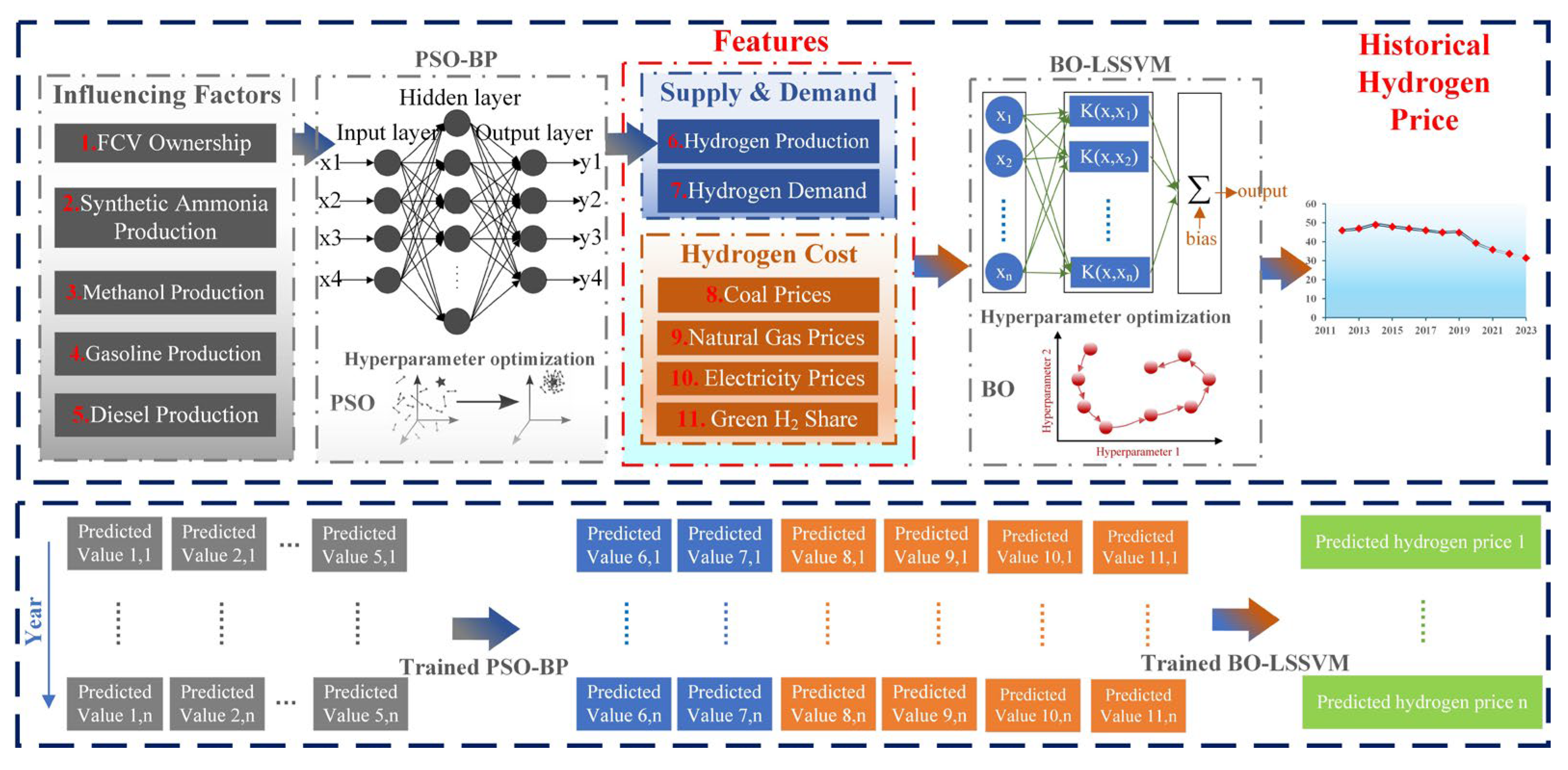


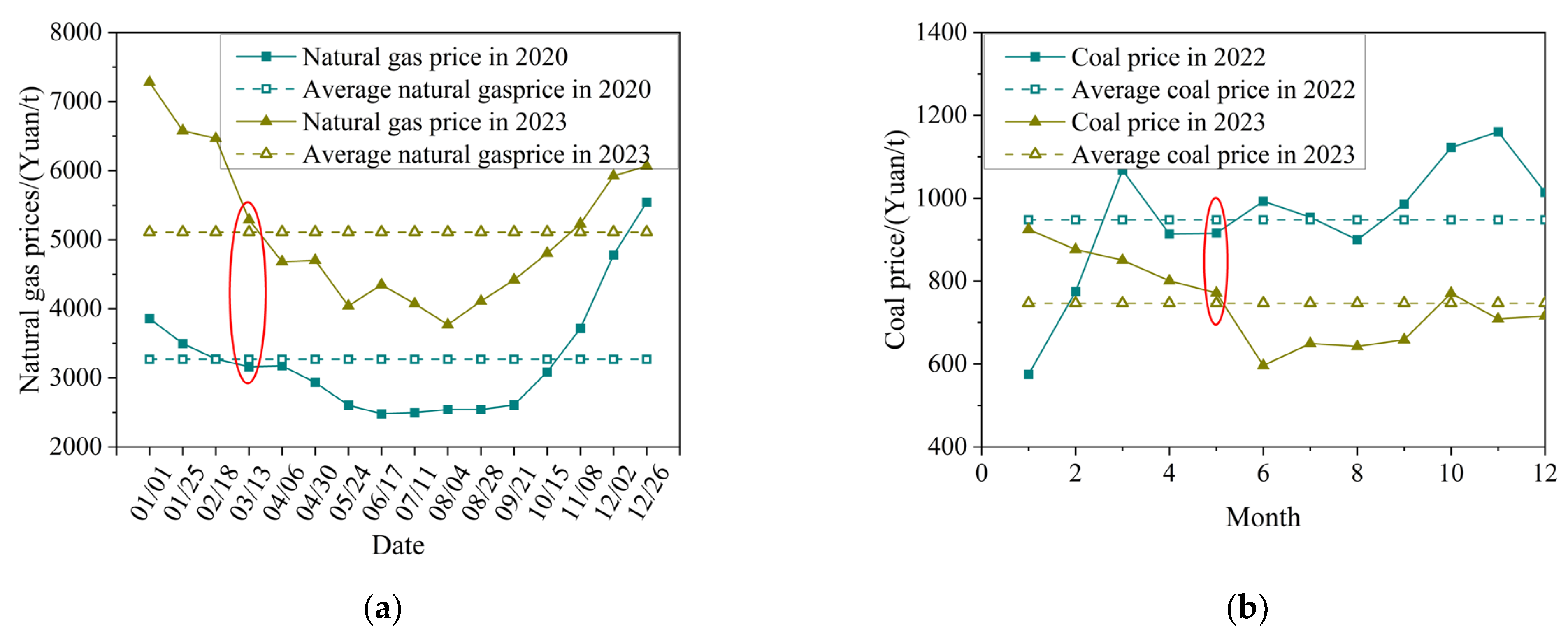
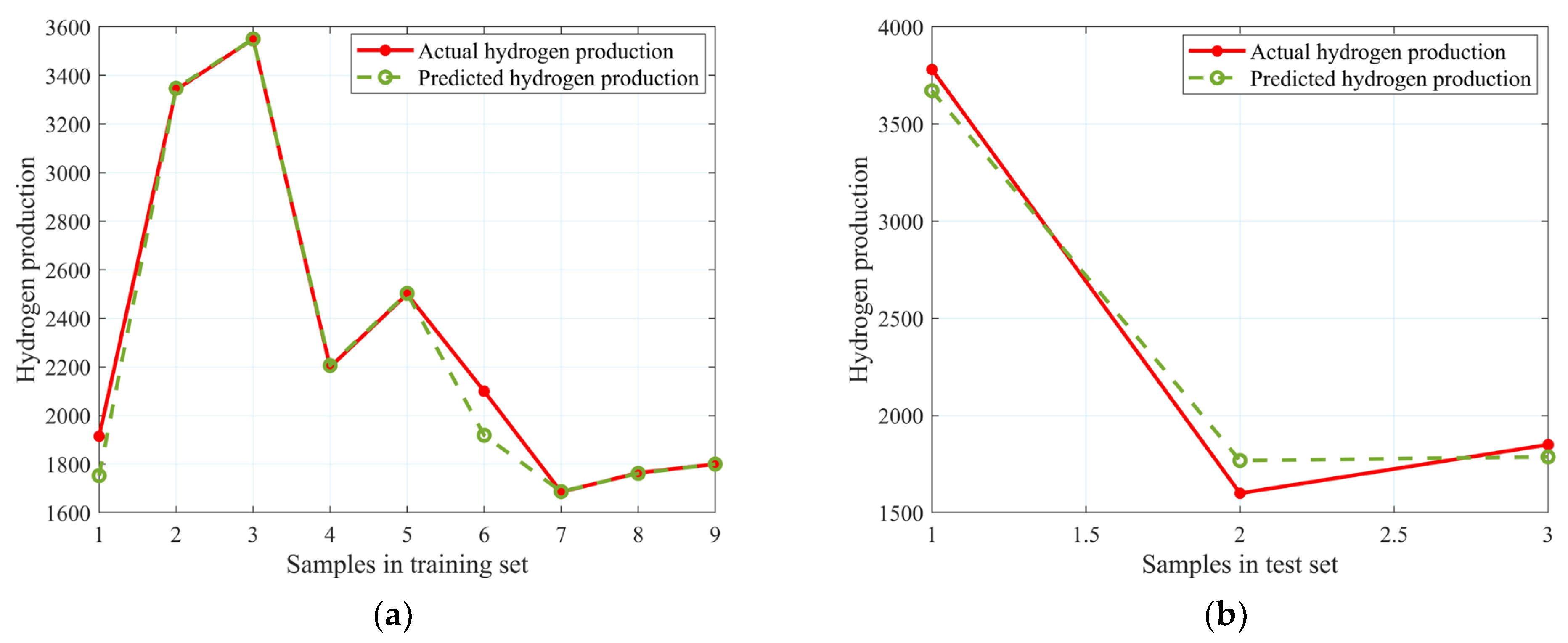

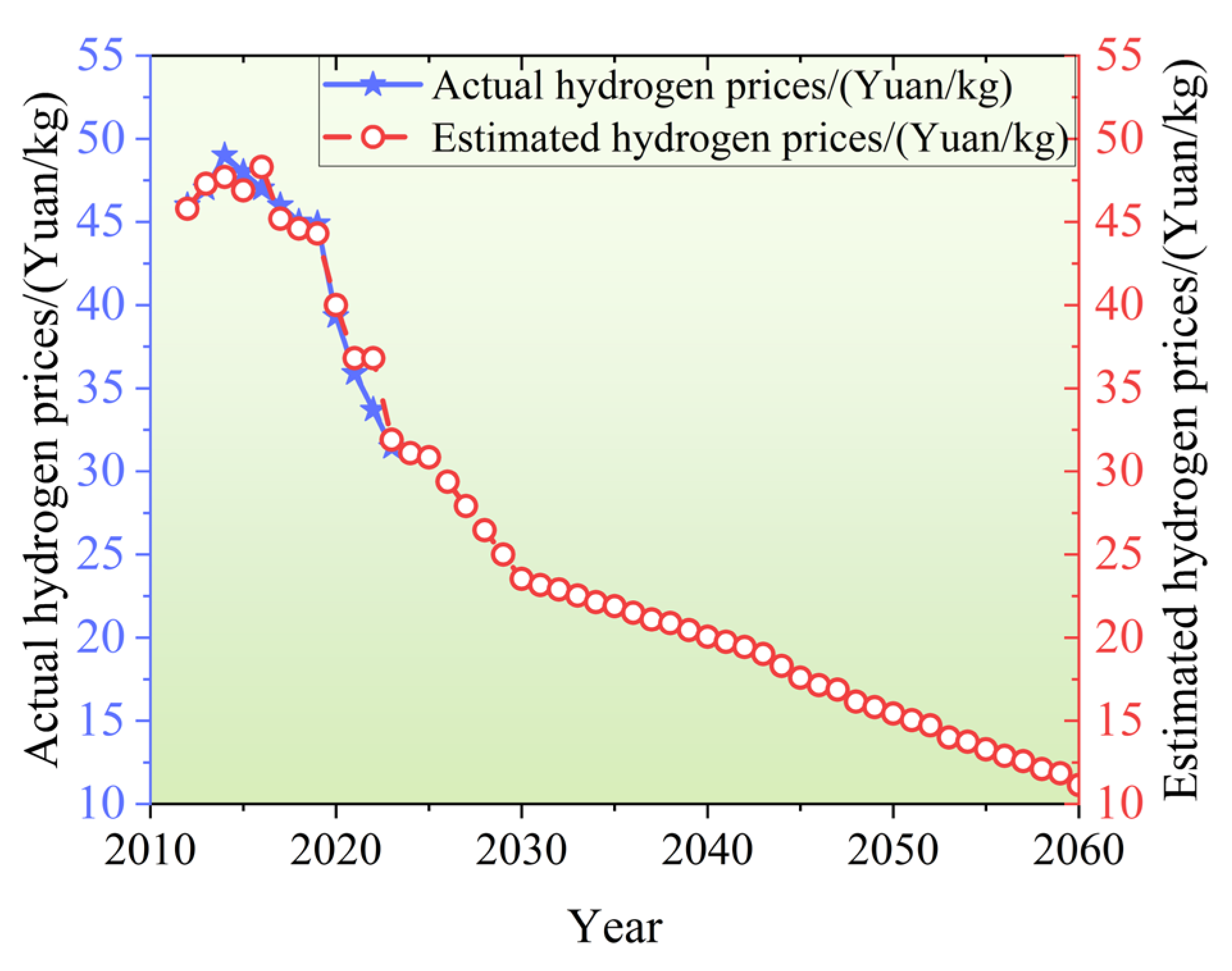

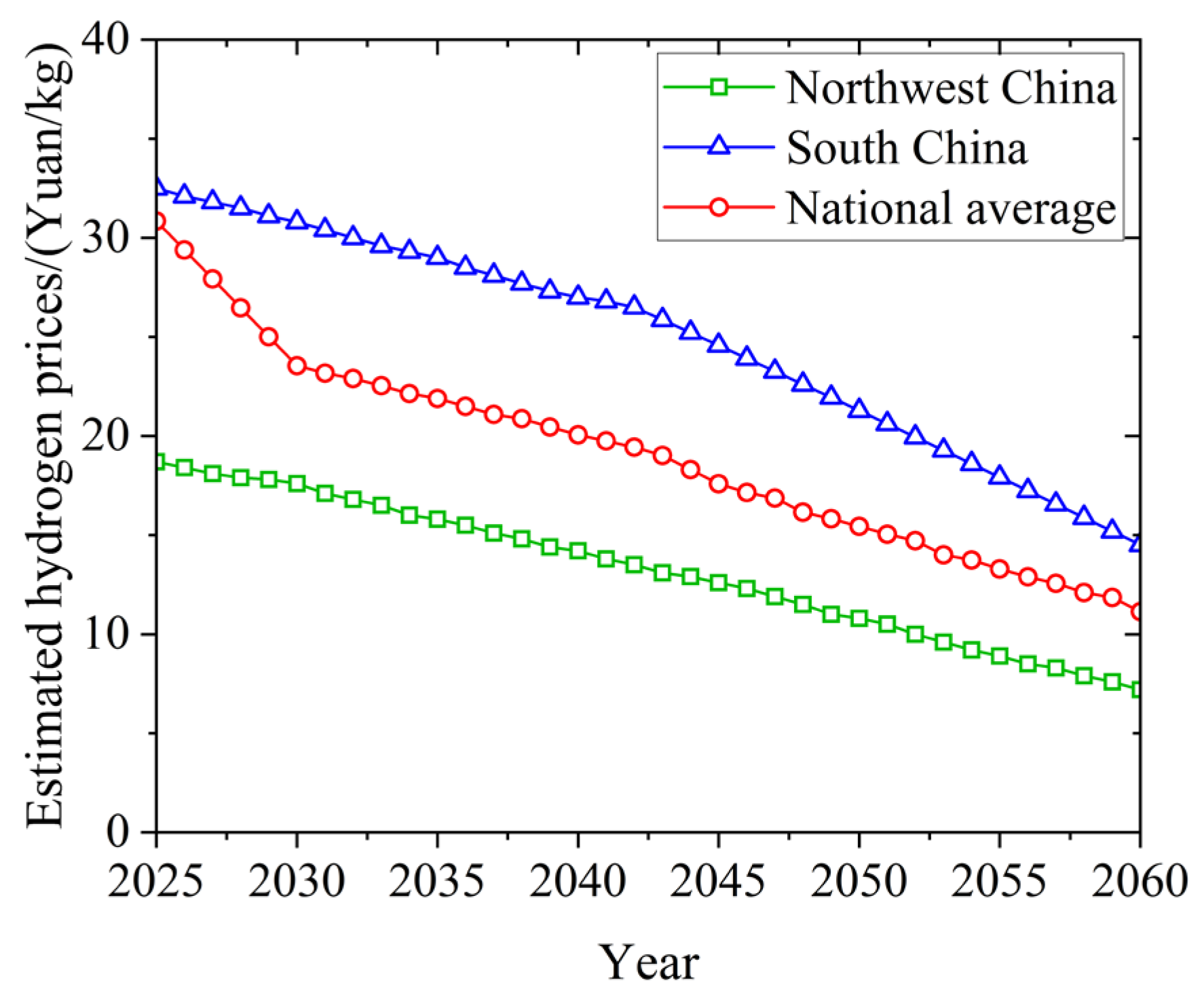
Disclaimer/Publisher’s Note: The statements, opinions and data contained in all publications are solely those of the individual author(s) and contributor(s) and not of MDPI and/or the editor(s). MDPI and/or the editor(s) disclaim responsibility for any injury to people or property resulting from any ideas, methods, instructions or products referred to in the content. |
© 2025 by the authors. Licensee MDPI, Basel, Switzerland. This article is an open access article distributed under the terms and conditions of the Creative Commons Attribution (CC BY) license (https://creativecommons.org/licenses/by/4.0/).
Share and Cite
Yin, C.; Jin, L. Estimating Hydrogen Price Based on Combined Machine Learning Models by 2060: Especially Comparing Regional Variations in China. Sustainability 2025, 17, 1049. https://doi.org/10.3390/su17031049
Yin C, Jin L. Estimating Hydrogen Price Based on Combined Machine Learning Models by 2060: Especially Comparing Regional Variations in China. Sustainability. 2025; 17(3):1049. https://doi.org/10.3390/su17031049
Chicago/Turabian StyleYin, Can, and Lifu Jin. 2025. "Estimating Hydrogen Price Based on Combined Machine Learning Models by 2060: Especially Comparing Regional Variations in China" Sustainability 17, no. 3: 1049. https://doi.org/10.3390/su17031049
APA StyleYin, C., & Jin, L. (2025). Estimating Hydrogen Price Based on Combined Machine Learning Models by 2060: Especially Comparing Regional Variations in China. Sustainability, 17(3), 1049. https://doi.org/10.3390/su17031049





